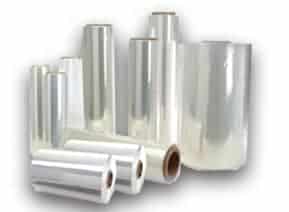Updated for 2018.
When it comes to choosing the correct shrink wrap film for your business and product, the volume of options on the market can often be misleading and confusing. Our latest blog is here to help you determine the main differences in form and function of the three primary types that people usually choose.
Polyvinyl (PVC), polyethylene (PE) and polyolefin (POF) shrink films have a variety of uses, but they are most frequently seen on the shelves of retail and food stores. Each of these types of films has different capabilities and characteristics that make them suitable for a specific application, which we will highlight and go into more detail about below.
Each type of shrink film mentioned above has been co-extruded. This is the process the wrap goes through to reach its final form. During this process, two or more layers of material are combined to form a single layer. These layers may be made out of polymers which each have a slightly different compound form. Co-extrude is usually utilised when the fusion of layered materials benefits the final packaging, for example, it may make the film much more durable, easier to shape or provides a more attractive appearance.
Shrink films can be formed into a wide variety of shapes, making it perfect for objects that have an unusual form. It can be moulded into bags, overwrap, banding and tubing, a tear-resistant protection can also be added.
Polyvinyl (PVC) Shrink Film – Pros and Cons
PVC shrink film is one of the most commonly used shrink packaging materials in the world, and this is primarily due to the fact that it is lightweight and inexpensive. The main qualities of PVC are that it is highly durable, has easily sealing and shrinking features, and it can be used on heat sensitive products. It is used in a wide variety of industries including food, pharmaceutical, construction, chemical, healthcare and many, many others.
PVC can also be used as a substitute to BOPP overwrap film, both of these types of wraps can have direct contact with food.
Polyolefin (POF) Shrink Film – Pros and Cons
POF or polyolefin shrink film is an extremely durable and versatile material. Polyolefin materials are available with many different characteristics. One of these characteristics is the cross-linked feature which provides high-tensile strength (tensile strength is the measurement of the force needed to break the wrap). POF also benefits from being transparent which allows the item enclosed to be clearly visible once it is wrapped.
The compounds of the wrap also reduce the likelihood of a build-up of the material on the sealing components of the machinery. This is hugely beneficial to many businesses as it reduces the maintenance and repair costs often associated with packaging.
As previously mentioned, POF has incredible strength, and because of this, it has a high resistance to punctures or tears. Not only is this beneficial throughout the supply and delivery chain, but it also means products which have an irregular shape can also be wrapped.
- It has excellent clarity and a glossy appearance; great for consumer products where appearance is critical.
- Ability to shrink quickly and completely.
- Durable, versatile, low cost.
- Excellent for bundling multiple items together.
Polyethylene (PE) Shrink Film – Pros and Cons
Polyethylene is a type of Polyolefin, which means it’s a single monomer that is formed by the addition of ethylene during polymerisation. PE is used in several forms of flexible protective packaging including shrink film and stretch film, yet it performs and forms very differently for each.
One of the primary uses of PE is during transit. Packs can either be wrapped individually or together, depending on what is the best option for the products and mode of transport. This versatility offers the best combination of unit cost and protection when compared to other packaging methods.
PE films tend to lack the visual properties and tight shrink features needed for most shrink film applications, hence why it is most frequently used during transportation. Unlike other shrink films, polyethylene does not shrink at the presence of heat, rather, it shrinks after exposure to heat.
PE is very elastic, and it has an array of other benefits, including its puncture resistant features and its durability. Like most other plastics it is rot resistant and it maintains its structural integrity over time.
PE film can also be used on a large range of goods, ranging from cans and jars to the individual wrapping of products to more industrial wrapping requirements such as buildings, boats and other large objects.
If you have any questions regarding shrink wrap film and which material is most suitable for your product and your business, please do not hesitate to contact us on 020 8952 8061 or email us on sales@kempner.co.uk and we will happily answer your queries and assist in finding a solution that suits you.



